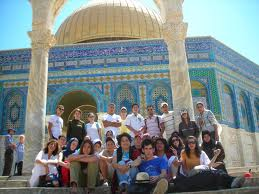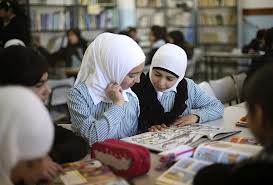In the short time Israel has been an independent nation, it has set optimal standards in the formation of a comprehensive and resilient educational system. As of 2011, the OECD has ranked Israel as the second most educated nation in the world. The Israeli government invests 78% of the nation’s public funds to education (Haaretz, 2012). However, Israel’s resilient and rapidly developing educational system is not the product increased financial funding but rather an active emergence of both its history and rich culture.
Historical events have played a critical role in the shaping of Israel’s educational system. Since the declaration of Israel’s independence in 1948, just three years after the marked ending of WWII, Jewish identity has been deeply enriched in the curriculum of Israeli schools. The Holocaust is marked as an event in history that defines Jewish identity. Educating students on the Holocaust is mandatory in the Israeli educational system and students study the Holocaust in depth. According to Gross (2010), Israeli youth view the Holocaust as the most important component in the formation of Jewish identity next to the establishment of the state of Israel. In addition, Israeli teachers and principals utilize Holocaust education to help students internalize humanistic values, teach pro-social behaviors, and enhance student’s connection to the Jewish faith (Gross 2010).
 Another historical event that has significantly shaped the development of the Israeli educational system is the flood of migration that occurred shortly after WWII. Large groups of Jewish immigrants from all over Europe, and other parts of the Middle East flooded the state of Israel. This event posed a great challenge to the development of the Israeli primary educational system because most of the immigrant population (i.e. school aged children) did not speak Hebrew, the national language. To address this issue, the Israeli government adopted the melting-pot policy. A uniform curriculum was implemented for all schools, in order to promote unity within a homogeneous society and to shadow differences and tensions between immigrant populations. Though the mindset of a homogenous society remained, it wasn’t long before the Israeli educational system underwent further policy reform. In the late 1960’s the Israeli Ministry of Education saw how the melting pot policy was ignoring tremendous differences between students learning styles. As a result the Israeli government designed a teaching approach that tailored to the individual needs of students, including those of special needs students. This led to more flexible curriculum for students of primary education such as electives and a multi-year curricular structure. Also, as a result, Israeli schools became more differentiated and autonomous while still adhering standardized assessments (Volansky, 2007).
Another historical event that has significantly shaped the development of the Israeli educational system is the flood of migration that occurred shortly after WWII. Large groups of Jewish immigrants from all over Europe, and other parts of the Middle East flooded the state of Israel. This event posed a great challenge to the development of the Israeli primary educational system because most of the immigrant population (i.e. school aged children) did not speak Hebrew, the national language. To address this issue, the Israeli government adopted the melting-pot policy. A uniform curriculum was implemented for all schools, in order to promote unity within a homogeneous society and to shadow differences and tensions between immigrant populations. Though the mindset of a homogenous society remained, it wasn’t long before the Israeli educational system underwent further policy reform. In the late 1960’s the Israeli Ministry of Education saw how the melting pot policy was ignoring tremendous differences between students learning styles. As a result the Israeli government designed a teaching approach that tailored to the individual needs of students, including those of special needs students. This led to more flexible curriculum for students of primary education such as electives and a multi-year curricular structure. Also, as a result, Israeli schools became more differentiated and autonomous while still adhering standardized assessments (Volansky, 2007).
In addition, Israel’s secondary and higher educational systems underwent a significant number of reforms since the late 1960’s. Before then secondary education wasn’t open to all Israeli pupils, and a selective system was used to grant certain students the opportunity move onto secondary schools. An even smaller percentage of students that graduated from secondary schooling went onto pursue higher education. Many Israeli students went straight into the workforce after graduating from primary education. The various reforms that the Israeli government implemented included extending required length of schooling time from age 16 to 18, creation of junior high schools, and the elimination screening tests required for entrance to secondary schools. Due to the various reforms in secondary education, many more Israeli students were able to move onto higher education. Higher education institutions also underwent various reforms including policies to increase the number of students admitted to higher education institutions and the creation of new academic programs such as communications, optometry, dental hygiene, tourism services etc (Volansky, 2007).
Despite migration and policy reform, the long standing conflict between Israel and Palestine has created divisions within the Israeli educational system. Religion, politics and cultural differences play a major role in the Arab/Israeli conflict which has led to the creation of Arab sectors where Muslim pupils attend schools in which their curriculum is taught in Arabic. The Israeli government supports the Arab sector for the purpose of accommodating for the ethnic, racial, and religious identity of the Arab people. Although most pupils who graduate from the Arab sector are fluent in Hebrew and go on to attend Israeli higher education institutions, the Israeli/Palestinian conflict is still heated (Volansky, 2007). A recent document published by the Israel/Palestine Center for Research and Information (IPCRI) discusses an agenda for changing Israel and Palestine’s educational textbooks and curricula to facilitate an integrated teaching approach that will slowly foster peace between the two nations. The document also discusses how there is nothing in Israeli or Palestinian text books that teaches students anything positive about the population they are in conflict with. The document also discusses policy reforms that the Israeli and Palestinian ministries of education can make to create an educational curriculum centered on fostering peace between the two nations (IPCRI, 2008). However despite this initiative, the Israeli/Arab conflict continues to have an impact on the Israeli educa tional system.
tional system.
Since the establishment of the state of Israel, the Israeli educational system has undergone many drastic reforms. The shaping of Israel’s educational system is deeply rooted in historical events such as the holocaust. Government policy reforms have helped create equal opportunity for Israeli citizens and immigrants to further their education and also pursue higher education. Despite Israeli’s melting pot philosophy, tensions still spur between Israel and Palestine and the Arabic sectors of education still exist within the nation. As of today, the Israeli educational system is built strongly on values of the Jewish faith, embracement of cultural diversity, encouragement of creativity, and standardized curriculum that is tailored towards the individual needs of students. Humanistic values and gender equality are also practiced in a typical classroom setting. Both genders are required to attend school from ages five to eighteen. A typical school year runs from September to July and students typically attend school six days a week (Classbase, 2012). The Israeli government continues to hold education as one of the nation top priorities and continues to set international standards.
Schools in Israel promote peace
References
Education system in Israel (n.d.). Retrieved February 22, 2013 from
http://www.classbase.com/Countries/Israel/Education-System
Gross, Z. (2010). Holocaust education in Jewish schools in Israel: Goals, dilemmas, challenges.
Prospects (Paris, France), 40(1), 93-113. Retrieved February 22, 2013 from
http://search.ebscohost.com/login.aspx?direct=true&db=eft&AN=508143174&site=ehost-live
Israeli-Palestinian negotiations for a culture of peace: Setting the agenda. (2008, April).
Israel/Palestine center for research and information. Retrieved February 22, 2013 from
http://www.ipcri.org/files/cop.pdf
Israel ranked second most educated country in the world, study shows. (2012, February).
Retrieved February 22, 2013, from http://www.haaretz.com/news/national/israel-
ranked-second-most-educated-country-in-the-world-study-shows-1.410415
Volansky, A. (2007). The Israeli education system. Document submitted for publication.
Retrieved February 22, 2013 from http://stwww.weizmann.ac.il/st_seminar8
/Volansky%20- http://stwww.weizmann.ac.il/st_seminar8/Volansky%20-
%20The%20Israeli%20Education%20System%20(English%2022007).pdf
Gross, Z. (2010). Holocaust education in Jewish schools in Israel: Goals, dilemmas, challenges.
Prospects (Paris, France), 40(1), 93-113. Retrieved February 22, 2013 from
http://search.ebscohost.com/login.aspx?direct=true&db=eft&AN=508143174&site=ehost-live


